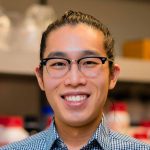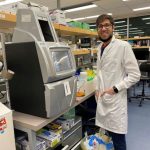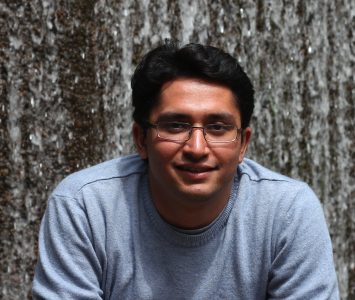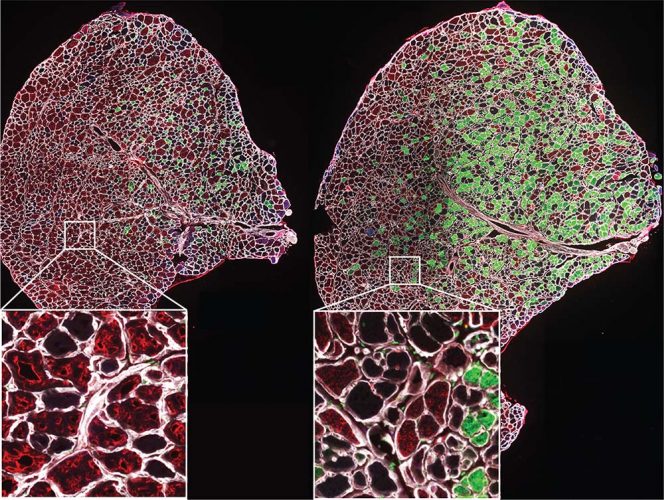

Written by: Steven Jiang, MSc Student, Kim Lab
Edited by: Ahmed Kabil, PhD Candidate, McNagny Lab

What role do tissue-resident macrophages play during in vivo regeneration in dystrophic muscle, and how can we rebuild the healthy tissue?
Duchenne’s muscular dystrophy (DMD) is a deadly disease caused by genetic mutations. People living with DMD often become wheelchair-bound in their teenage years and many pass away in their late twenties. Currently, there is no cure for this serious disease. The only treatment for this disease is corticosteroids, which causes severe side effects, such as cataract and osteoporosis.
In a recent study1 published by Dr. Farshad Babaeijandaghi and Prof. Fabio Rossi, they discovered a new drug for DMD called colony-stimulating factor 1 receptor inhibitor (CSF1R inhibitor). CSF1R inhibitor can potentially slow down the progression of DMD, allowing patients to enjoy a more active lifestyle and a longer lifespan. I had the honor of interviewing Farshad about this project. Unbeknown to many people, it was seven years of tireless work with multiple failures and heartbreak before this great success.
The story began when Farshad studied tissue-resident macrophages, a type of white blood cell responsible for eating and killing invading pathogens. Their role within the injured muscle is poorly understood due to the lack of specific markers for their identification. Farshad and Dr. Fabio Rossi identified TIM4 as a unique marker expressed by tissue-resident macrophages. By removing all TIM4-expressing tissue-resident macrophages, they could determine their elusive function in the muscle. However, unknown to Farshad at the time, TIM4 expression levels in tissue-resident macrophages is low. Therefore, it was not feasible to remove tissue-resident macrophages using TIM4-mediated strategies. After committing a large amount of time and resources, the research came to a halt.
Farshad and Fabio… searched for other ways to knock-out tissue-resident macrophages. They stumbled on CSF1R inhibitors, which have been used to remove both tissue-resident macrophages and monocyte-derived macrophages in other areas of biomedical research.

However, Farshad and Fabio did not give up. They searched for other ways to knock-out tissue-resident macrophages. They stumbled on CSF1R inhibitors, which have been used to remove both tissue-resident macrophages and monocyte-derived macrophages in other areas of biomedical research. Using a special dosing regimen on mice, they could selectively remove TIM4-containing tissue-resident macrophages from muscle tissues. When they examined mice that developed DMD, they fortuitously found that CSF1R inhibitors could deplete tissue-resident and monocyte-derived macrophages, thereby slowing down the progression of DMD. After performing further analysis, they found that CSF1R inhibitor treatment changed the composition of muscle fibers from a faster-twitching type to a slower-twitching type. Because slower-twitching muscle fibers are less susceptible to damage in DMD, this effect allowed muscle wasting to occur much more slowly.
Up to this point, Farshad has spent five years on this project. However, it took Farshad and Fabio two additional years to edit the article and to perform the additional experiments before it was published. Farshad says, “It was intense and tiring, but when it was published, it was a relief.” After its publication, Farshad and Fabio received much recognition from other scientists and media coverage. They were happy.
I asked Farshad about the future direction of this project. Although the negotiation with the drug company was ongoing and many more tests were required, he was optimistic. Because CSF1R inhibitors have been tested in humans and are shown to be safe, the drug development process will be much faster. Farshad is hopeful to see this drug be used to treat DMD patients in the future. Despite the failures and heavy workload, he never gave up. It was because of his perseverance that this great discovery was made.
“The journey is what makes science challenging but interesting. Believing in that, it will help you move on from failure, keep going, and become stronger. At the end of the day, it will turn out to be a great discovery.”
— Dr. Farshad Babaeijandaghi
Finally, he wants to encourage other scientists who are struggling with their projects, “If something disappointing happens, it can still turn out good. Don’t get disappointed. The journey is what makes science challenging but interesting. Believing in that, it will help you move on from failure, keep going, and become stronger. At the end of the day, it will turn out to be a great discovery.”
References
1 Babaeijandaghi, F., Cheng, R., Kajabadi, N., Solimani, H., Chang, C., Smandych, J., Tung, L. W., Long, R., Ghassemi, A., & V Rossi, F. M. (2022). Metabolic reprogramming of skeletal muscle by resident macrophages points to CSF1R inhibitors as muscular dystrophy therapeutics. Science Translational Medicine, 14(651). https://www.science.org/doi/10.1126/scitranslmed.abg7504


